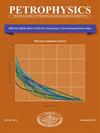致密油岩石应力相关渗透率微观结构研究
IF 0.7
4区 工程技术
Q3 ENGINEERING, PETROLEUM
引用次数: 9
摘要
1. 最近对致密油储层岩心塞尺度样品的研究表明,随着净围应力的增加,致密油岩石的渗透率会出现显著的、不可逆的下降。由于这种效应与油田压降过程中预期的应力变化密切相关,因此这种现象的起源以及预测相对于不同岩石类型的强度的方法对油藏管理具有重要意义。为了更好地理解这种效应,我们进行了一系列的原位研究,证明了外部应力场如何在孔隙尺度上转化为微观应变,并与流体输送耦合。这些研究依赖于低场核磁共振(NMR)和x射线微断层扫描(XMT)的协同使用。利用标记流体增强对比度,我们能够直接解决局部应变如何影响流体在整个岩心桥塞中的输送。以类似的方式,质子核磁共振解决了应力如何耦合到各种孔隙系统的变形,影响流体含量及其动力学。总之,这些技术表明,内部的高渗透途径在应力依赖性中起着重要作用。基质渗透率受影响较小。这些高渗透率层在致密油岩中并不普遍。表征这些带并将其与矿物学和岩石结构联系起来,是提高储层岩石类型应力相关渗透率可预测性的一个有吸引力的途径。本文章由计算机程序翻译,如有差异,请以英文原文为准。
Microstructural Investigation of Stress-Dependent Permeability in Tight-Oil Rocks
1. ABSTRACT Recent studies on several core-plug scale samples from tight oil reservoirs have demonstrated that such rocks can exhibit a significant, irreversible permeability decline with increase in net confining stress. Because this effect closely follows the expected stress change during drawdown in the field, the origins of this phenomena as well as a method to predict the magnitude relative to different rock types is valuable information for reservoir management. To better understand this effect, we have undertaken a series of in situ studies that demonstrate how an external stress field translates to microscopic strain at the pore scale and couples to the fluid transport. These studies rely on the coordinated use of low-field Nuclear Magnetic Resonance (NMR) and X-ray Microtomography (XMT). Making use of labeled fluids to enhance contrast, we are able to directly resolve how local strains affect fluid transport throughout the core plug. In a similar manner, proton NMR resolves how stress couples to deformation of the various pore systems, affecting the fluid content and their dynamics. Together, these techniques indicate that internal, high-permeability pathways play an important role in the stress dependence. Matrix permeability is much less affected. These higher-permeability zones are not ubiquitous in tight-oil rocks. Characterizing these zones and relating them to mineralogy and rock fabric is an attractive pathway to greater predictability for stressdependent permeability for reservoir rock types.
求助全文
通过发布文献求助,成功后即可免费获取论文全文。
去求助
来源期刊

Petrophysics
地学-地球化学与地球物理
CiteScore
1.80
自引率
11.10%
发文量
40
审稿时长
>12 weeks
期刊介绍:
Petrophysics contains original contributions on theoretical and applied aspects of formation evaluation, including both open hole and cased hole well logging, core analysis and formation testing.
 求助内容:
求助内容: 应助结果提醒方式:
应助结果提醒方式:


